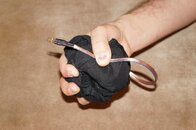FWIW, I picked up some of this material and used it to heat a motorcycle vest; I had a zip out liner on one of my riding jackets, and I sewed a zig zag of the material from the left side, just inside the zipper, to the right side (around the back). I then ran the 12V leads up the left and right sides of the zipper, effectively paralleling five meters of the material and giving me about 1.3 ohms more or less. It works fantastically on the bike and is very comfortable.
One thing I will say is that you want to protect the carbon fiber tape. That material snags very easily; even the straight pins I used to hold while sewing were an issue. I covered mine with tape.
I've used this stuff diving before...been diving a heated vest now for five or six years. It's not an issue, as long as you remember a few points:
- you must use an external battery to your drysuit... you'd be an idiot (who likes to get zapped) if you didn't have a way to disconnect power from the outside of your suit. It's not going to kill you, but it's not nice when you get zapped by it.
- you have to commit to using the vest once you turn it on. You should have power to leave it on the rest of the dive. You'll sweat, which makes you get colder if you turn off the vest. You'll also have vasoconstriction when you get colder if you turn off the vest, and that's a really bad thing for deco.
- you want to run the vest ideally at the end of your dive, not during the working portion.
- you shouldn't be planning a dive where your thermal protection strategy necessitates the heated vest.
Neoprene is a fine substrate for this vest...in fact, it's a great, sturdy, and flexible substrate. I've made a couple of similar vests that way, and at least one commercial manufacturer sells them that way. You just need a wicking fabric between you and the neoprene/heater. This plan doesn't create a skin-tight suit nor one that covers more than the primary core body area (where it can heat the blood most effectively)...air will move around in there on the edges.
This is one of the best, easiest to work with, and gentle ways I've seen to heat something up. Love it...
 .. best to use insulated carbon fibre wire on thin breathable material.
.. best to use insulated carbon fibre wire on thin breathable material.




